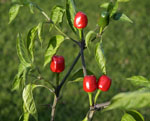AKABARE KHURSANI
 |
ALTERNATIVE NAMES: | Akabare Khursani |
| ORIGIN: | Nepal \ India | |
| SPECIES: | C. annuum | |
| SHU min. | 50.000 | |
| SHU max. | 100.000 |
 Akabare Khursani: C. annuum.
Akabare Khursani: C. annuum.
Una rara varietà originaria dal Nepal e Sikkim in India. Conosciuto anche come Dalle Khursani. Il nome Akabare Khursani può essere tradotto come: Re dei peperoncini, mentre Dalle Khursani come: Peperoncino rotondo. Tuttavia esisto alcune differenze che (a nostro parere) le rendono due varietà distinte. L'Akabare Khursani cresce rivolto verso l'alto e con una attaccatura del calice molto ampia, mentre il Dalle Khursani cresce rivolto verso il basso, ha una attaccatura del calice più piccola e mostra una costrizione anulare che ci porta a pensare che sia una caratteristica chinense. La pianta ha una struttura ad alberello con foglie verde scuro. I fiori sono bianchi con antere viola e gialle. I frutti misurano mediamente 2 cm in larghezza e 3 cm in lunghezza. Maturano dal verde al arancione al rosso. Molto usato durante i freddi mesi invernali nella cucina tradizionale Nepalese per la preparazione di Dahl e Curry o sottaceto. Generalmente è coltivato in piccole quantità nei giardini privati per i mercati locali ma attualmente si sta avviando anche la coltura commerciale. 50.000 - 100.000 SHU.
Sembra esistere un'altra specie in Nepal chiamata Jeere Khursani, forse C. frutescens, il cui nome deriva dalla sua forma simile ai semi di Cumino (Jeera).
 Akabare Khursani: C. annuum.
Akabare Khursani: C. annuum.
A rare variety originating from Nepal and Sikkim in India. Also known as Dalle Khursani. The name Akabare Khursani can be translated as: King of chillies, while Dalle Khursani as: Round chilli. However, there are some differences that (in our opinion) make them two distinct varieties. The Akabare Khursani grows upward and with a very large chalice attachment, while the Dalle Khursani grows downward, has a smaller chalice attachment and shows an annular constriction that leads us to think that it is a characteristic chinense. The plant has a tree-like structure with dark green leaves. The flowers are white with purple and yellow anthers. The fruits measure on average 2 cm in width and 3 cm in length. They ripen from green to red. Very used during the cold winter months in the traditional Nepalese cuisine for the preparation of Dahl and Curry or pickled. It is generally grown in small quantities in private gardens for local markets but currently commercial cultivation is also being started. 50.000 - 100.000 SHU.
There seems to be another species in Nepal called Jeere Khursani, perhaps C. frutescens, whose name derives from its similar shape to the seeds of Cumin (Jeera).
 Akabare Khursani: C. annuum.
Akabare Khursani: C. annuum.
Una variedad rara originaria de Nepal y Sikkim en India. También conocido como Dalle Khursani. El nombre Akabare Khursani se puede traducir como: Rey de los chiles, mientras que Dalle Khursani como: Chile redondo. Sin embargo, hay algunas diferencias que (en nuestra opinión) los convierten en dos variedades distintas. El Akabare Khursani crece hacia arriba y con un accesorio de cáliz muy grande, mientras que el Dalle Khursani crece hacia abajo, tiene un accesorio de cáliz más pequeño y muestra una constricción anular que nos lleva a pensar que es un chinense característico. La planta tiene una estructura similar a un árbol con hojas de color verde oscuro. Las flores son blancas con anteras moradas y amarillas. Los frutos miden en promedio 2 cm de ancho y 3 cm de largo. Maduran de verde a rojo. Muy utilizado durante los fríos meses de invierno en la cocina tradicional nepalí para la preparación de Dahl y Curry o en escabeche. Generalmente se cultiva en pequeñas cantidades en jardines privados para los mercados locales, pero actualmente también se está iniciando el cultivo comercial. 50.000 - 100.000 SHU.
Parece que hay otra especie en Nepal llamada Jeere Khursani, quizás C. frutescens, cuyo nombre deriva de su forma similar a las semillas de comino (Jeera).
 Akabare Khursani: C. annuum.
Akabare Khursani: C. annuum.
Eine seltene Sorte aus Nepal und Sikkim in Indien. Ist auch als Dalle Khursani bekannt. Der Name Akabare Khursani kann übersetzt werden als: König der Chilis, während Dalle Khursani als: Runde Chilis. Es gibt jedoch einige Unterschiede, die sie (unserer Meinung nach) zu zwei unterschiedlichen Sorten machen. Der Akabare Khursani wächst nach oben und mit einem sehr großen Kelchaufsatz, während der Dalle Khursani nach unten wächst, einen kleineren Kelchaufsatz hat und eine ringförmige Verengung aufweist, die uns glauben lässt, dass es sich um ein charakteristisches Chinense handelt. Die Pflanze hat eine baumartige Struktur mit dunkelgrünen Blättern. Die Blüten sind weiß mit violetten und gelben Staubbeuteln. Die Früchte sind durchschnittlich 2 cm breit und 3 cm lang. Sie reifen von grün nach rot. Sehr beliebt in den kalten Wintermonaten in der traditionellen nepalesischen Küche für die Zubereitung von Dahl und Curry oder eingelegt. Es wird im Allgemeinen in kleinen Mengen in privaten Gärten für lokale Märkte angebaut, aber derzeit wird auch mit dem kommerziellen Anbau begonnen. 50.000 - 100.000 SHU.
Es scheint eine andere Art in Nepal zu geben, Jeere Khursani, vielleicht C. frutescens, deren Name sich von der ähnlichen Form wie die Samen von Kreuzkümmel (Jeera) ableitet.
Other images: |
 |
Video: |

